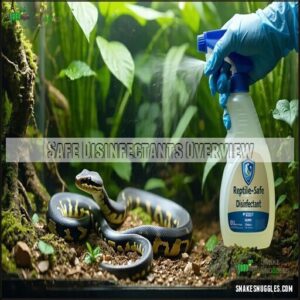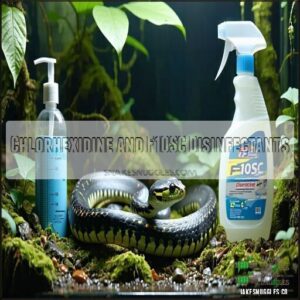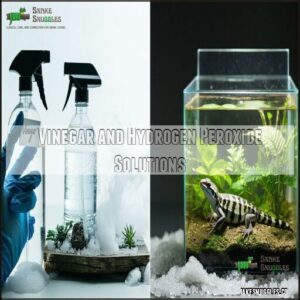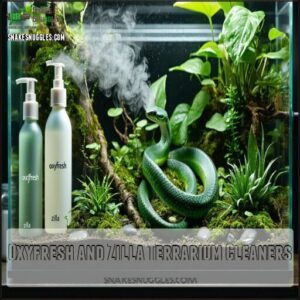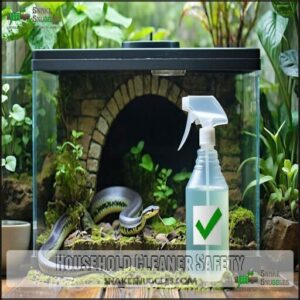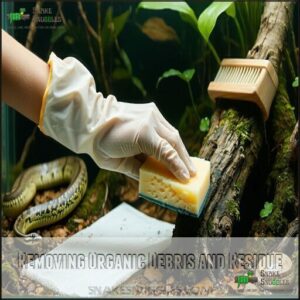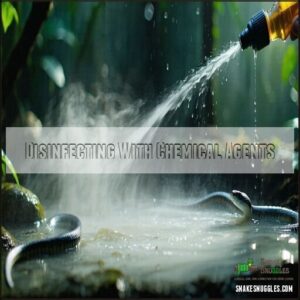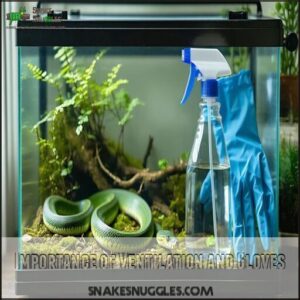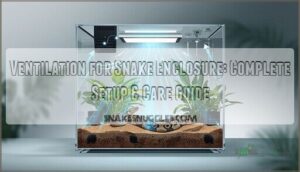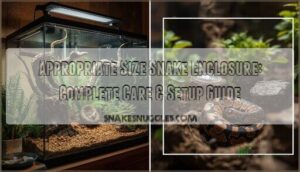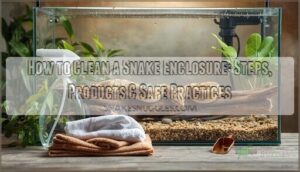This site is supported by our readers. We may earn a commission, at no cost to you, if you purchase through links.
 When cleaning your snake’s enclosure, stick to safe disinfectants like F10SC, chlorhexidine, or a diluted vinegar-water mix (1:1 ratio works well).
When cleaning your snake’s enclosure, stick to safe disinfectants like F10SC, chlorhexidine, or a diluted vinegar-water mix (1:1 ratio works well).
These are gentle on your snake but tough on germs. Avoid harsh chemicals like bleach, ammonia, or anything heavily scented—they can harm your snake’s respiratory system or stress them out.
Always rinse thoroughly after disinfecting and let items dry completely. And a pro tip: spot cleaning daily can save you headaches later!
Think of it like changing the sheets regularly—nobody likes a messy home. Curious about other safe options? There’s more where that came from!
Table Of Contents
- Key Takeaways
- Safe Disinfectants Overview
- Reptile Friendly Cleaning Agents
- Household Cleaner Safety
- Cleaning and Disinfecting Techniques
- Enclosure Maintenance and Hygiene
- Frequently Asked Questions (FAQs)
- How to disinfect a snake enclosure?
- What is a safe antiseptic for reptiles?
- How do you make reptile safe disinfectant?
- What household cleaners are safe for reptiles?
- How often should reptile-safe disinfectants be rotated?
- Are UV sanitizers safe for disinfecting enclosures?
- Can improper rinsing cause health issues for snakes?
- What’s the best way to clean bioactive setups?
- Do disinfectant residues affect humidity levels in tanks?
- Conclusion
Key Takeaways
- Stick to reptile-safe disinfectants like F10SC, chlorhexidine, or a diluted vinegar-water mix to protect your snake’s health.
- Avoid harmful cleaners like bleach, ammonia, or phenol-based products, which can irritate your snake and leave toxic residues.
- Always rinse thoroughly after cleaning and let everything dry completely to prevent residue or moisture issues.
- Daily spot-cleaning and regular deep-cleaning routines help maintain a safe, hygienic habitat for your snake.
Safe Disinfectants Overview
You’ll need to use the right disinfectants in your snake’s enclosure to avoid harmful fumes and residues that could make your scaly friend sick.
Choosing reptile-safe products like chlorhexidine, F10SC, or properly diluted vinegar solutions will effectively clean your pet’s home without risking those dreaded late-night emergency vet visits, which can be caused by harmful fumes.
Reptile-safe disinfectants like F10SC or chlorhexidine ensure a clean enclosure and a healthy snake, sparing you midnight vet emergencies.
Risks of Harmful Cleaners
Many household cleaners pose serious threats to your snake’s health.
Household cleaners can silently endanger your snake, turning their safe haven into a harmful hazard—choose reptile-safe options instead.
Using the wrong products can lead to severe health issues or even be fatal.
- Bleach solutions cause skin irritation and respiratory distress
- Ammonia-based cleaners risk chemical burns and GI damage
- Mixing cleaners (like bleach with hidden ammonia) creates toxic gases
- Phenols found in Lysol are highly toxic to reptiles
- Residue dangers persist long after cleaning
Always choose a reptile-safe disinfectant to protect your scaly friend’s health.
A good option is to use diluted chlorhexidine solutions to ensure a safe environment.
Benefits of Reptile-Safe Cleaners
While harmful cleaners can damage your snake’s health, reptile-safe disinfectants offer peace of mind and tangible benefits.
They maintain reptile health while controlling odors without introducing toxins.
Your snake experiences reduced stress since these cleaners don’t irritate sensitive respiratory systems.
You’ll also enjoy cost savings over time—reptile-specific disinfectants help prevent vet visits from chemical exposure issues.
Plus, nontoxic snake cleaners protect everyone in your home, not just your scaly friend, by providing a safe environment.
Importance of Proper Dilution
Now that you’ve chosen reptile-safe cleaners, you’ll need to master proper dilution.
Even the safest reptile cage disinfectants can harm your snake if mixed incorrectly. Think of dilution instructions as a recipe—too strong and you risk toxicity, too weak and you lose efficacy.
Always measure accurately using proper tools (not "eyeballing it"). Most snake enclosure cleaners have specific mixing ratios with built-in safety margins to protect your scaly friend.
Reptile Friendly Cleaning Agents
You’ll need cleaners that won’t make your scaly friend sick when you’re scrubbing their home, and products like chlorhexidine, F10SC, and diluted vinegar solutions are perfect for the job.
Unlike harsh household cleaners that can harm reptiles, these snake-safe options effectively kill bacteria and fungi without leaving behind toxic residues.
That could turn your pet’s palace into a danger zone.
Chlorhexidine and F10SC Disinfectants
You need a safe reptile cleaner that works without causing harm.
Chlorhexidine and F10SC are star snake enclosure cleaners. Both offer veterinary usage and broad-spectrum efficacy.
- Chlorhexidine: Affordable, versatile, and great for regular use.
- F10SC: A reptile-safe disinfectant with unmatched potency when diluted properly.
Both options excel as snake enclosure cleaners—no stress, just clean.
F10SC is available from various retailers, making it a convenient option for reptile owners.
Vinegar and Hydrogen Peroxide Solutions
Using natural cleaners like a vinegar solution (50/50 dilution) or hydrogen peroxide (3% strength) guarantees safe disinfectants for enclosures.
Avoid mixing dangers—never combine these! Vinegar deodorizes; peroxide tackles microbes.
Rinse thoroughly to skip residue risks. Gloves protect your skin while cleaning.
Proper enclosure size and design also helps maintain a healthy environment.
| Cleaner | Use | Safe Dilution | Application | Precautions |
|---|---|---|---|---|
| Vinegar | General cleaning | 1:1 water dilution | Glass/debris cleaning | Avoid mixing with others |
| Hydrogen Peroxide | Disinfection | Use at 3% strength | Surfaces/enclosures | Gloves and ventilation |
| Both Separately | Deodorize & Clean | Follow labels | Spot fixes/deodorizers | Rinsing completely |
Oxyfresh and Zilla Terrarium Cleaners
Oxyfresh stands out as a reptile-safe disinfectant, boasting odor-fighting Oxygene for spotless, streak-free cleaning.
Meanwhile, Zilla’s Terrarium Cleaner combines non-toxic ingredients with anti-static properties, making it perfect as a safe snake cage cleaner.
Both excel in efficacy, with Oxyfresh tackling odors and Zilla preventing dust buildup. Their long-term effects guarantee your snake enclosure stays fresh without harmful residues—cleaner comparison is a win-win!
You can find reptile cleaner products online.
Household Cleaner Safety
You might think everyday cleaners are safe, but many contain hidden dangers like ammonia or harsh chemicals that can harm your snake.
Knowing what’s safe and what’s not can help you avoid accidental risks and keep your scaly friend healthy.
Dangers of Bleach and Ammonia
Chlorine bleach and ammonia aren’t just risky—they’re downright dangerous for snake enclosures.
Besides causing respiratory irritation and chemical burns, their accidental mixing creates toxic gas.
Even solo, their fumes and residue risks can harm your snake long after use.
Skip the panic and stick to safe disinfectants. Your pet’s health shouldn’t hinge on hazardous household cleaners.
Hidden Ammonia in Household Cleaners
Ammonia sources often hide in glass cleaners or multipurpose sprays, making accidental mixing with bleach dangerous.
Poor labeling practices can mislead you, creating risks like toxic fumes or respiratory damage.
For snake enclosure sanitation, stick to ammonia-free cleaners or reptile enclosure disinfectants.
Safe swaps like vinegar or hydrogen peroxide guarantee health impacts are minimized, keeping your snake safe and habitat fresh.
Safe Alternatives to Bleach and Ammonia
Why risk your snake’s health with harsh chemicals?
Here are five bleach alternatives that are safe and effective:
- Vinegar solutions: Affordable, nontoxic snake cleaner.
- F10SC benefits: A top reptile-safe disinfectant.
- Chlorhexidine safety: Powerful and reptilesafe.
- Hydrogen peroxide: Mild, natural bleach alternative.
- Enzyme cleaners: Remove odors safely.
Switch to these ammoniafree cleaners for peace of mind!
To further prevent illness, consider that proper humidity control is essential.
Cleaning and Disinfecting Techniques
You’ll need to master both cleaning and disinfecting to keep your snake’s enclosure safe and fresh.
Removing waste and using the right tools, like gloves and proper ventilation, makes the process easier and protects your scaly friend.
Removing Organic Debris and Residue
Cleaning starts with removing organic matter like waste and leftover food to avoid residue buildup.
Use proper tools like brushes and soap-free sponges for safe rinsing.
Stick to a consistent cleaning frequency to prevent messes.
Regular substrate replacement is important for preventing bacterial growth.
maintaining snake hygiene techniques Check out this quick guide:
| Task | Tool | Water Temperature |
|---|---|---|
| Spot-cleaning | Paper towel | Warm |
| Scrubbing decor | Soft brush | Hot |
| Wiping surfaces | Detergent-free sponge | Lukewarm |
Disinfecting With Chemical Agents
A safe disinfectant can make your life easier and your snake happier.
Use these five proven options:
- Chlorhexidine: Effective for bacteria and odors with precise dilution ratios.
- F10SC: A broad disinfectant spectrum for tough pathogens.
- Hydrogen peroxide: Affordable and safe when dried thoroughly.
- Vinegar solutions: Natural, affordable, versatile.
- Commercial snake-safe deodorizers: Designed for sensitive enclosures.
Remember contact time matters!
Importance of Ventilation and Gloves
When using safe disinfectants in snake enclosures, don’t underestimate fume exposure. Chemical burns aren’t fun—for you or your snake.
Ventilation systems are your best friend, so crack a window or use a fan. Gloves matter too; choose durable glove material to shield your hands.
Safe handling protects both you and your pet, keeping your little slither buddy healthy.
Enclosure Maintenance and Hygiene
Keeping your snake’s enclosure clean isn’t just about appearances—it’s about their health and comfort too.
A regular routine of spot cleaning, deep cleaning, and disinfecting accessories guarantees your pet stays safe in a fresh, hygienic habitat.
Daily Spot Cleaning and Deep Cleans
A tidy snake enclosure isn’t just about looks—it’s health insurance for your pet.
Daily spot cleaning is your go-to for waste removal, water renewal, and substrate checks. Schedule deep cleans monthly.
Use a snake-safe cleaning routine to tackle stubborn grime and odors.
- Look for residue and clean with a reptile-safe tank cleaner.
- Wash accessories weekly for odor control.
- Dry thoroughly before reintroducing your snake.
Replacing Substrate and Water
A snake’s home isn’t spotless without fresh substrate and water.
Check substrate types regularly—some need swapping monthly to control waste buildup, while others last longer.
Water sanitation is just as essential; refresh it daily to support hydration needs.
Use a safe disinfectant like a reptile cage cleaner to scrub soiled water bowls.
Your snake deserves nothing less!
Disinfecting Hides and Accessories
Once you’ve tackled substrate and water changes, don’t forget about disinfecting accessories.
Pay special attention to porous hides—germs hide in hard-to-reach spots! Apply a reptile-safe disinfectant, ensuring proper contact time for complete sanitation.
Rinse thoroughly to avoid residues, and dry completely before returning items.
Proper sanitation requires a suitable snake hide cleaner. A clean snake cage cleaner can keep your snake happy, healthy, and stylishly housed.
Frequently Asked Questions (FAQs)
How to disinfect a snake enclosure?
Did you know bacteria multiply by millions overnight?
Remove the snake first, scrub with mild soap, rinse thoroughly, then apply a diluted reptile-safe disinfectant like F10SC.
Rinse again, dry completely, and reintroduce the snake.
What is a safe antiseptic for reptiles?
Chlorhexidine is a safe antiseptic for reptiles.
It’s gentle on their skin, effective against bacteria and viruses, and easy to use when diluted properly.
Just follow the instructions, and you’re good to go with properly diluted Chlorhexidine.
How do you make reptile safe disinfectant?
Mix 50% white vinegar with 50% water for an affordable, reptile-safe disinfectant.
It’s natural, effective, and cheap—just rinse thoroughly after use.
Bonus: It’s kitchen-friendly, so grab it while waiting for noodles to boil!
What household cleaners are safe for reptiles?
Not all cleaners are created equal—vinegar-water mixes (50/50), diluted hydrogen peroxide (3%), or rubbing alcohol (isopropyl) work safely.
Just make certain of thorough drying and rinsing to leave no harmful residues behind for your reptile buddy.
How often should reptile-safe disinfectants be rotated?
Rotate reptile-safe disinfectants every 6-12 months to prevent microorganism resistance.
Mixing it up keeps bacteria and viruses guessing.
Just like you’d avoid eating the same meal daily, your cleaning routine needs variety too, and by doing so, you ensure that the disinfectants remain effective.
Are UV sanitizers safe for disinfecting enclosures?
UV sanitizers can work for surfaces but don’t completely replace traditional cleaning methods.
They’re safe if used correctly, but they won’t disinfect crevices or remove grime.
Think of them as a handy sidekick, not the hero.
Can improper rinsing cause health issues for snakes?
Improper rinsing leaves harmful residues, like unseen villains, lurking on surfaces.
These residues can irritate a snake’s skin, damage their respiratory system, or cause digestive issues.
Always rinse thoroughly—your snake’s health depends on it!
What’s the best way to clean bioactive setups?
Focus on spot-cleaning waste and debris daily while ensuring drainage works well.
For deep cleaning, remove décor, wipe surfaces gently with a snake-safe disinfectant, and rinse thoroughly.
Careful not to disturb beneficial microbes!
Do disinfectant residues affect humidity levels in tanks?
Think of humidity as the pulse of your tank’s ecosystem.
Disinfectant residues can disrupt it by absorbing moisture or altering evaporation rates.
Always rinse thoroughly to keep the balance and maintain a healthy, stable environment.
Conclusion
An ounce of prevention is worth a pound of cure, especially when choosing safe disinfectants for snake enclosures.
Stick with trusted options like F10SC, chlorhexidine, or diluted vinegar to keep your snake healthy and stress-free.
Avoid harsh chemicals—they’re a recipe for trouble.
Remember to rinse thoroughly, dry surfaces completely, and clean regularly to maintain a hygienic habitat.
Your snake will thrive in a clean, safe environment, and you’ll enjoy less hassle in the long run!
- https://www.merckvetmanual.com/toxicology/household-hazards/chlorine-bleaches
- https://www.reptilesrus.ca/chlorhexidine-2-solution-473-ml/
- https://www.reddit.com/r/reptiles/comments/19az8cq/reptile_enclosure_cleaners_to_steer_clear_of_for/
- https://www.cfsph.iastate.edu/pdf/antimicrobial-spectrum-of-disinfectants
- http://www.beautifuldragons.com/Disinfectants.html

